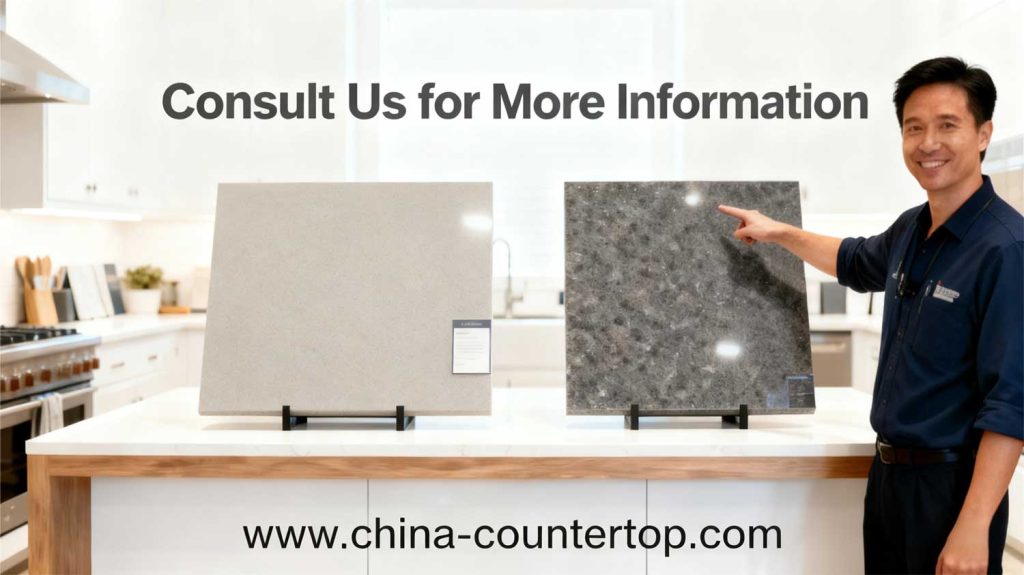The countertop industry is witnessing a significant transformation as manufacturers and fabricators explore new materials that offer enhanced performance and aesthetics. For years, quartz slabs have dominated the market as the premium choice for residential and commercial surfaces. However, a new contender—sintered stone—is gaining traction and prompting many to question whether we’re seeing a fundamental shift in material preference.As a leading manufacturer of both quartz and sintered stone slabs, we at China Countertop have observed this evolving trend firsthand. In this article, we’ll explore the reasons behind this potential shift, compare the properties of both materials, and discuss what this means for countertop fabricators and their clients.

Understanding the Materials: Quartz vs. Sintered Stone
Before analyzing the shift, it’s essential to understand what distinguishes these two popular materials:
Quartz Slabs
Quartz countertops are engineered stone products made from approximately 90-95% ground natural quartz blended with polymers, resins, and pigments. This composition creates a non-porous, durable surface that resists staining and requires minimal maintenance.
Sintered Stone Slabs
Sintered stone is created through a process of extreme heat and pressure that fuses natural minerals without using resins. This manufacturing technique results in an ultra-compact surface with exceptional durability, heat resistance, and UV stability, making it suitable for both indoor and outdoor applications.
Why Are Countertop Makers Considering the Shift?
Several factors are driving fabricators to explore sintered stone as an alternative to quartz:
1. Enhanced Durability and Performance
Sintered stone offers superior resistance to heat, UV rays, scratches, and stains compared to quartz. While quartz can be damaged by excessive heat (above 150°C/300°F), sintered stone can withstand much higher temperatures without damage, making it ideal for kitchen applications where hot pots and pans are frequently placed directly on the surface.
2. Greater Design Versatility
Sintered stone slabs often feature more realistic veining and patterns that closely mimic natural stone like marble and granite. Advanced digital printing technology allows for incredibly realistic reproductions of natural stone patterns without the maintenance challenges associated with natural materials.
3. Expanding Application Possibilities
Due to its UV resistance and weather durability, sintered stone can be used for both indoor and outdoor applications, including facades, patio countertops, and pool surrounds—applications where quartz would be unsuitable.
4. Health and Sustainability Considerations
Sintered stone contains no resins or VOCs (volatile organic compounds), making it a healthier choice for indoor environments. Additionally, its composition of natural minerals makes it fully recyclable, aligning with growing consumer demand for sustainable building materials.
Quartz vs. Sintered Stone: A Detailed Comparison
| Feature | Quartz Slabs | Sintered Stone Slabs |
|---|---|---|
| Composition | 90-95% quartz with resins | 100% natural minerals (no resins) |
| Heat Resistance | Moderate (up to 150°C/300°F) | Excellent (up to 400°C/750°F) |
| UV Resistance | Limited (may discolor over time) | Excellent (no fading) |
| Stain Resistance | Excellent | Excellent |
| Scratch Resistance | Very Good | Excellent |
| Applications | Indoor use only | Indoor & outdoor use |
| Installation | Standard fabrication techniques | Requires specialized tools |
| Cost | Premium | Premium to Ultra-Premium |
The Fabrication Perspective: Challenges and Opportunities
For countertop makers considering the transition to sintered stone, several factors need consideration:
Fabrication Requirements
Sintered stone’s extreme hardness requires specialized cutting and polishing equipment. Fabricators need to invest in diamond-tipped tools and water jets to work with this material effectively. While this represents an initial investment, it positions fabricators to serve a growing premium market segment.
Installation Considerations
Due to its weight and brittleness during handling, sintered stone requires careful installation. However, once installed, it offers exceptional long-term performance with minimal maintenance requirements.
Market Positioning
Offering sintered stone allows fabricators to target the high-end residential and commercial markets where clients seek the ultimate in performance and aesthetics. This diversification can help businesses differentiate themselves in a competitive marketplace.
Is This a Complete Shift or Market Diversification?
While sintered stone is gaining popularity, it’s important to note that quartz remains an excellent choice for many applications. Rather than a complete replacement, we’re seeing market diversification where:
- Quartz continues to dominate the mainstream premium countertop market
- Sintered stone captures the ultra-premium segment and specialized applications
- Fabricators increasingly offer both materials to serve different client needs
The choice between quartz and sintered stone ultimately depends on the specific requirements of each project, including budget, performance needs, and design preferences.
Explore Our Premium Quartz and Sintered Stone Collections
Whether you’re considering quartz, sintered stone, or both for your projects, China Countertop offers premium-quality slabs with consistent coloring and superior performance characteristics. Our extensive collection includes a wide range of colors, patterns, and finishes to suit any design vision.
Contact us today to request samples or discuss your specific project requirements.
Conclusion
The countertop industry is indeed experiencing a gradual shift toward sintered stone, particularly in the premium and ultra-premium segments. While quartz continues to be an excellent choice for most residential applications, sintered stone offers enhanced performance characteristics that make it ideal for high-traffic commercial spaces, outdoor applications, and projects where extreme durability is required.
Forward-thinking countertop makers are adapting to this trend by expanding their material offerings and investing in the necessary fabrication capabilities. Rather than viewing this as quartz versus sintered stone, the most successful fabricators are positioning themselves to offer both materials, providing clients with the right solution for each specific application.
As manufacturers continue to innovate in both quartz and sintered stone technologies, we can expect both materials to evolve, offering even greater design possibilities and performance characteristics in the years to come.

